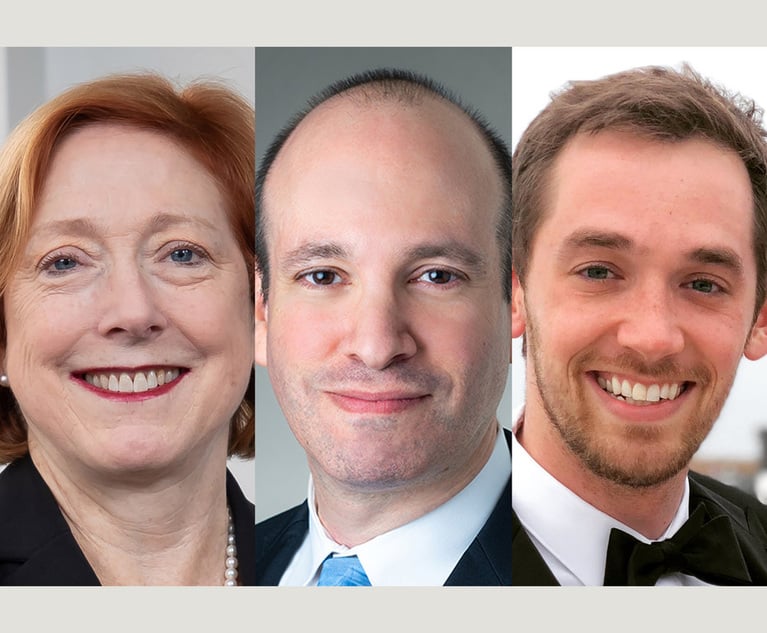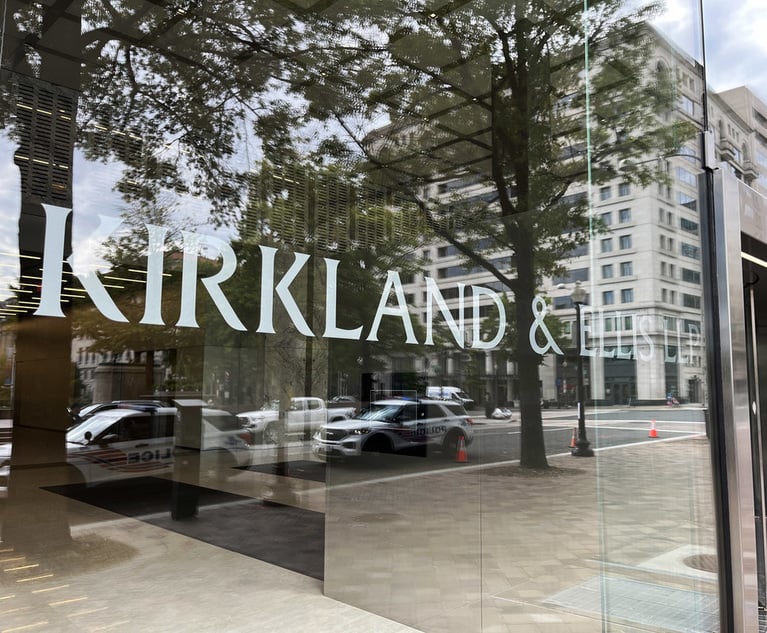Percentage of New Women Partners Rising Slowly; Still Low Compared to Men
The number of women promoted to partner reached a six-year high in 2017, but women still only account for 38.1 percent of all new partners among top law firms, according to a new report.
November 09, 2017 at 05:38 PM
35 minute read

A record number of women made partner in 2017, but female attorneys still lag far behind their male counterparts in promotions to partnership, according to a new report by the Diversity & Flexibility Alliance.
Using data from more than 133 Big Law firms, the report found that women made up 38.1 percent of newly promoted partners—up from 37 percent last year—while men accounted for 61.9 percent of promotions in 2017.
“I still think it shows that there's a lot more work to do,” said Manar Morales, president and CEO of the Diversity & Flexibility Alliance. “Even as it continues to creep up, it's doing it at a pretty glacial pace.”
In 2012—the year the Alliance began collecting its data—roughly 33 percent of newly promoted partners were women. That percentage remained fairly stagnant until 2016, when women accounted for 36 percent of partnership classes.
“We are seeing it going in the right direction, albeit quite slowly,” Morales said. “But it's clear from the trends and numbers that [there's] a lot more to be done.”
One highlight of the report Morales noted was that 43 law firms, or roughly 32 percent of firms surveyed, had new partner classes consisting of more than 50 percent women—the largest since the study began four years ago.
Cravath, Swaine & Moore, Goldberg Kohn, Hunton & Williams, Kramer Levin Naftalis & Frankel and Pepper Hamilton each advanced only women last year.
Firms that had the highest percentage of women promoted included Pillsbury Winthrop Shaw Pittman, which elevated five women among six newly selected partners; Steptoe & Johnson, which promoted four women and one man; and Parker Poe Adams & Bernstein and Paul Hastings, which each elevated three women among four newly elected partners.
Ten firms, however, promoted no women to partnership status. This statistic ties with 2016 for the smallest number of firms with no women in their partnership class.
Fish & Richardson promoted eight men and no women to its partnership. Andrews Kurth Kenyon and Womble Carlyle Sandridge & Rice (which is now Womble Bond Dickinson), elevated four men and no women. Gibbons, Munger, Tolles & Olson, Paul, Weiss, Rifkind, Wharton & Garrison, Shearman & Sterling, and Sullivan & Cromwell each had three promotions—all male.
“Given the amount of focus that firms are putting on diversity and trying to make sure that they get their partnership to look more diverse, I would've expected more growth,” said Alycia Ziarno, a commercial litigation partner at Nixon Peabody's Washington, D.C., office, who was part of the firm's promotional class in 2017 that consisted of seven men and seven women.
When she was up for partnership, Ziarno said that the firm made sure to take into account that some practice groups tended to promote more women than others, and pushed its practices to advance women in all areas.
“We've made the conscious effort as a firm to look at [gender diversity] and that is taken into account as a part of the partnership evaluation in who are the candidates that you're going to promote,” she said.

A record number of women made partner in 2017, but female attorneys still lag far behind their male counterparts in promotions to partnership, according to a new report by the Diversity & Flexibility Alliance.
Using data from more than 133 Big Law firms, the report found that women made up 38.1 percent of newly promoted partners—up from 37 percent last year—while men accounted for 61.9 percent of promotions in 2017.
“I still think it shows that there's a lot more work to do,” said Manar Morales, president and CEO of the Diversity & Flexibility Alliance. “Even as it continues to creep up, it's doing it at a pretty glacial pace.”
In 2012—the year the Alliance began collecting its data—roughly 33 percent of newly promoted partners were women. That percentage remained fairly stagnant until 2016, when women accounted for 36 percent of partnership classes.
“We are seeing it going in the right direction, albeit quite slowly,” Morales said. “But it's clear from the trends and numbers that [there's] a lot more to be done.”
One highlight of the report Morales noted was that 43 law firms, or roughly 32 percent of firms surveyed, had new partner classes consisting of more than 50 percent women—the largest since the study began four years ago.
Firms that had the highest percentage of women promoted included
Ten firms, however, promoted no women to partnership status. This statistic ties with 2016 for the smallest number of firms with no women in their partnership class.
“Given the amount of focus that firms are putting on diversity and trying to make sure that they get their partnership to look more diverse, I would've expected more growth,” said Alycia Ziarno, a commercial litigation partner at
When she was up for partnership, Ziarno said that the firm made sure to take into account that some practice groups tended to promote more women than others, and pushed its practices to advance women in all areas.
“We've made the conscious effort as a firm to look at [gender diversity] and that is taken into account as a part of the partnership evaluation in who are the candidates that you're going to promote,” she said.
This content has been archived. It is available through our partners, LexisNexis® and Bloomberg Law.
To view this content, please continue to their sites.
Not a Lexis Subscriber?
Subscribe Now
Not a Bloomberg Law Subscriber?
Subscribe Now
NOT FOR REPRINT
© 2025 ALM Global, LLC, All Rights Reserved. Request academic re-use from www.copyright.com. All other uses, submit a request to [email protected]. For more information visit Asset & Logo Licensing.
You Might Like
View All
Quiet Retirement Meets Resounding Win: Quinn Emanuel Name Partner Kathleen Sullivan's Vimeo Victory

T14 Sees Black, Hispanic Law Student Representation Decline Following End of Affirmative Action

Fired Kirkland Associate's Gender Bias Lawsuit to Enter Private Mediation

Duane Morris Uses Nonequity Partnership as 'Income Shifting' Device, Class Action Contends
5 minute readTrending Stories
- 1Microsoft Becomes Latest Tech Company to Face Claims of Stealing Marketing Commissions From Influencers
- 2Coral Gables Attorney Busted for Stalking Lawyer
- 3Trump's DOJ Delays Releasing Jan. 6 FBI Agents List Under Consent Order
- 4Securities Report Says That 2024 Settlements Passed a Total of $5.2B
- 5'Intrusive' Parental Supervision Orders Are Illegal, NY Appeals Court Says
Who Got The Work
J. Brugh Lower of Gibbons has entered an appearance for industrial equipment supplier Devco Corporation in a pending trademark infringement lawsuit. The suit, accusing the defendant of selling knock-off Graco products, was filed Dec. 18 in New Jersey District Court by Rivkin Radler on behalf of Graco Inc. and Graco Minnesota. The case, assigned to U.S. District Judge Zahid N. Quraishi, is 3:24-cv-11294, Graco Inc. et al v. Devco Corporation.
Who Got The Work
Rebecca Maller-Stein and Kent A. Yalowitz of Arnold & Porter Kaye Scholer have entered their appearances for Hanaco Venture Capital and its executives, Lior Prosor and David Frankel, in a pending securities lawsuit. The action, filed on Dec. 24 in New York Southern District Court by Zell, Aron & Co. on behalf of Goldeneye Advisors, accuses the defendants of negligently and fraudulently managing the plaintiff's $1 million investment. The case, assigned to U.S. District Judge Vernon S. Broderick, is 1:24-cv-09918, Goldeneye Advisors, LLC v. Hanaco Venture Capital, Ltd. et al.
Who Got The Work
Attorneys from A&O Shearman has stepped in as defense counsel for Toronto-Dominion Bank and other defendants in a pending securities class action. The suit, filed Dec. 11 in New York Southern District Court by Bleichmar Fonti & Auld, accuses the defendants of concealing the bank's 'pervasive' deficiencies in regards to its compliance with the Bank Secrecy Act and the quality of its anti-money laundering controls. The case, assigned to U.S. District Judge Arun Subramanian, is 1:24-cv-09445, Gonzalez v. The Toronto-Dominion Bank et al.
Who Got The Work
Crown Castle International, a Pennsylvania company providing shared communications infrastructure, has turned to Luke D. Wolf of Gordon Rees Scully Mansukhani to fend off a pending breach-of-contract lawsuit. The court action, filed Nov. 25 in Michigan Eastern District Court by Hooper Hathaway PC on behalf of The Town Residences LLC, accuses Crown Castle of failing to transfer approximately $30,000 in utility payments from T-Mobile in breach of a roof-top lease and assignment agreement. The case, assigned to U.S. District Judge Susan K. Declercq, is 2:24-cv-13131, The Town Residences LLC v. T-Mobile US, Inc. et al.
Who Got The Work
Wilfred P. Coronato and Daniel M. Schwartz of McCarter & English have stepped in as defense counsel to Electrolux Home Products Inc. in a pending product liability lawsuit. The court action, filed Nov. 26 in New York Eastern District Court by Poulos Lopiccolo PC and Nagel Rice LLP on behalf of David Stern, alleges that the defendant's refrigerators’ drawers and shelving repeatedly break and fall apart within months after purchase. The case, assigned to U.S. District Judge Joan M. Azrack, is 2:24-cv-08204, Stern v. Electrolux Home Products, Inc.
Featured Firms
Law Offices of Gary Martin Hays & Associates, P.C.
(470) 294-1674
Law Offices of Mark E. Salomone
(857) 444-6468
Smith & Hassler
(713) 739-1250










